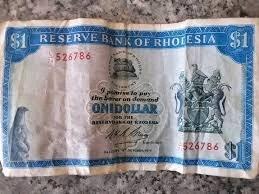Opinion / Columnist
Monetary history of Zimbabwe
2 hrs ago |
56 Views

The British South Africa Company did not initially introduce a formal monetary system in its territories. Instead, during the 1890s, the region adopted the monetary legislation of the Cape Colony, allowing South African currencies to circulate widely. This arrangement lasted until 1938, when Britain created a currency board for Southern Rhodesia, which issued the Southern Rhodesian Pound as a distinct currency. The board's jurisdiction also included Northern Rhodesia and Nyasaland, separating all three from the South African monetary area.
With the formation of the Central African Federation in 1954, the currency area was renamed, although the new Central African Pound remained identical to its predecessor. The arrangement held until 1964, when Rhodesia withdrew from the common currency area shared with Malawi and Zambia. That July, the Reserve Bank of Rhodesia was established, and the Rhodesian Pound became the national currency. Initially pegged to the Pound Sterling, it was later linked to the US Dollar after Britain devalued its currency in 1967.
In 1970, Rhodesia decimalised its currency, introducing the 1st Zimbabwean (Rhodesian) Dollar, valued at half a Pound. This currency was then pegged to the South African Rand in December 1971. When Zimbabwe attained independence in 1980, the central bank was renamed and new banknotes and coins replaced earlier issues over the following year. The Rand peg had already been abandoned in March 1980 under the transitional government, and by the mid-1980s, the Zimbabwean Dollar had depreciated by more than 60%.
A brief period of stability followed, but depreciation resumed in 1988 and accelerated steadily. By the end of 2002, the currency had lost 98% of its value. In February 2003, it suffered a further 93% devaluation, after which the exchange rate was allowed to float - triggering the onset of hyperinflation.
Zimbabwe began a series of redenominations in response. In August 2006, three zeros were removed to introduce the 2nd Zimbabwean (New) Dollar. Hyperinflation continued, prompting another redenomination in August 2008, this time removing ten zeros to create the 3rd Zimbabwean (Revalued) Dollar. At the peak of hyperinflation in January 2009, a further twelve zeros were cut, producing the 4th Zimbabwean Dollar. The government simultaneously legalized the use of foreign currencies - primarily the US Dollar and South African Rand - which were valued daily.
In April 2009, Zimbabwe suspended its own currency altogether in favour of a multi-currency system anchored by the US Dollar. This suspension became permanent in 2015, after the Zimbabwean currency - having lost a total of 22 zeros - was officially abolished.
Meanwhile, in late 2014, the Reserve Bank of Zimbabwe introduced bond coins, followed in 2016 by low-denomination bond notes, both denominated in US Dollars and intended to ease transactions. Although initially pegged 1:1 to the US Dollar, these instruments evolved into a parallel currency, trading at a growing discount.
In October 2018, the central bank initiated preparations to reintroduce a national currency. Commercial banks were ordered to separate foreign currency nostro accounts from domestic US Dollar-denominated balances, the latter renamed RTGS accounts (Real-Time Gross Settlement). In February 2019, RTGS balances and bond money were devalued by 60% against the US Dollar - effectively creating the 5th Zimbabwean Dollar. The reintroduction was formalized in June 2019 when the Zimbabwean Dollar became the sole legal tender, ending the multi-currency regime.
Immediately after its return, the currency entered a renewed inflationary decline. By mid-2020, it had lost 85% of its value, despite the central bank's efforts to manage the float.
With the formation of the Central African Federation in 1954, the currency area was renamed, although the new Central African Pound remained identical to its predecessor. The arrangement held until 1964, when Rhodesia withdrew from the common currency area shared with Malawi and Zambia. That July, the Reserve Bank of Rhodesia was established, and the Rhodesian Pound became the national currency. Initially pegged to the Pound Sterling, it was later linked to the US Dollar after Britain devalued its currency in 1967.
In 1970, Rhodesia decimalised its currency, introducing the 1st Zimbabwean (Rhodesian) Dollar, valued at half a Pound. This currency was then pegged to the South African Rand in December 1971. When Zimbabwe attained independence in 1980, the central bank was renamed and new banknotes and coins replaced earlier issues over the following year. The Rand peg had already been abandoned in March 1980 under the transitional government, and by the mid-1980s, the Zimbabwean Dollar had depreciated by more than 60%.
A brief period of stability followed, but depreciation resumed in 1988 and accelerated steadily. By the end of 2002, the currency had lost 98% of its value. In February 2003, it suffered a further 93% devaluation, after which the exchange rate was allowed to float - triggering the onset of hyperinflation.
Zimbabwe began a series of redenominations in response. In August 2006, three zeros were removed to introduce the 2nd Zimbabwean (New) Dollar. Hyperinflation continued, prompting another redenomination in August 2008, this time removing ten zeros to create the 3rd Zimbabwean (Revalued) Dollar. At the peak of hyperinflation in January 2009, a further twelve zeros were cut, producing the 4th Zimbabwean Dollar. The government simultaneously legalized the use of foreign currencies - primarily the US Dollar and South African Rand - which were valued daily.
In April 2009, Zimbabwe suspended its own currency altogether in favour of a multi-currency system anchored by the US Dollar. This suspension became permanent in 2015, after the Zimbabwean currency - having lost a total of 22 zeros - was officially abolished.
Meanwhile, in late 2014, the Reserve Bank of Zimbabwe introduced bond coins, followed in 2016 by low-denomination bond notes, both denominated in US Dollars and intended to ease transactions. Although initially pegged 1:1 to the US Dollar, these instruments evolved into a parallel currency, trading at a growing discount.
In October 2018, the central bank initiated preparations to reintroduce a national currency. Commercial banks were ordered to separate foreign currency nostro accounts from domestic US Dollar-denominated balances, the latter renamed RTGS accounts (Real-Time Gross Settlement). In February 2019, RTGS balances and bond money were devalued by 60% against the US Dollar - effectively creating the 5th Zimbabwean Dollar. The reintroduction was formalized in June 2019 when the Zimbabwean Dollar became the sole legal tender, ending the multi-currency regime.
Immediately after its return, the currency entered a renewed inflationary decline. By mid-2020, it had lost 85% of its value, despite the central bank's efforts to manage the float.
Source - online
All articles and letters published on Bulawayo24 have been independently written by members of Bulawayo24's community. The views of users published on Bulawayo24 are therefore their own and do not necessarily represent the views of Bulawayo24. Bulawayo24 editors also reserve the right to edit or delete any and all comments received.
Join the discussion
Loading comments…











